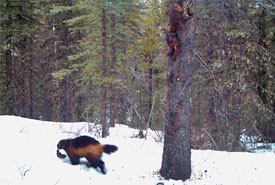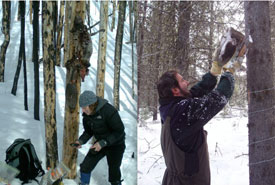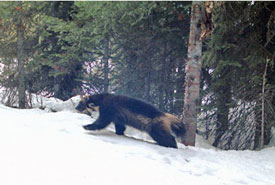The elusive wolverine: Beyond the X-Men character

The elusive wolverine. This individual was caught on camera making off from the bait station with a large piece of beaver carcass. (Photo by InnoTech Alberta and Alberta Environment & Parks)
When you think of a wolverine, do you think of an elusive, almost mythical creature with superpowers, or do you think of the comic book character? Most people have heard of X-Men, either through the movies or the comic book series, but few people know about the real-life inspiration behind the mutant character, Wolverine.
Wolverines (Gulo gulo), like their X-Men counterpart, enjoy their “alone time” and few people are lucky enough to see one in real life. Even wolverine researchers Nicole Heim and Jason Fisher admit they have never seen one off camera. The closest Jason came was tracking a snarling wolverine through the snow — but even though he heard it making terrifying noises at him, he just couldn’t get close enough for a visual ID.
So how do you research an animal that’s so elusive? It is a challenge! Wolverines are not only elusive, their home ranges can be large — 100 to 600 square kilometres, depending on their sex and location.

Nicole Heim (left) and Jason Fisher (right) caught on camera setting up one of their bait stations. (Photo by N. Heim and J. Fisher)
Nicole and Jason are part of the Alberta Wolverine Working Group, a team trying to compare wolverine population density and behaviours in the Rocky Mountain national parks (Banff, Yoho and Kootenay), where human disturbance is minimal, and Kananaskis Country, a mixed-use area where human disturbance is more common. To do this they use a series of camera traps baited with a juicy beaver carcass. That carcass makes an irresistible meal, attracting local wolverines (and a slew of other hungry animals like martens, fishers, red and flying squirrels, and even Clark’s nutcrackers, among many others) for a mid-meal photo op.

The wolverine known as Hookneck, whose colouration patterns make him easy to identify. His movement over the study site ranged nearly 1,000 square kilometres. (Photo by InnoTech Alberta and Alberta Environment & Parks)
Each camera trap station allows for a visual ID of individuals with distinct colouration patterns, like Hookneck (photo, left), as well as genetic identification material from hair snagged by barbed wire.
Nicole and Jason’s research had some surprising results. They found that the wolverine population in Banff, Yoho and Kootenay national parks was around 50 individuals, with a population of only seven individuals in the adjacent (but less protected) Kananaskis Country.

The study area in the Canadian Rocky Mountains stretches from the Willmore Wilderness in the north, to Banff and Yoho national parks in the south. Dots indicate bait stations, each consisting of a camera trap and hair snag. (Photo by InnoTech Alberta.)
The prevailing thinking in the U.S. wolverine research community is that populations are decreasing (and ranges shrinking) because of climate change. However, the Alberta Wolverine Working Group is showing that climate change is only half of the problem. Landscape change due to human use is the other big culprit, and the animals are avoiding habitats that have been disturbed by resource extraction. But it’s not just human activity pushing the wolverines out — other medium-sized carnivores that do well in human-impacted landscapes may be increasing, leading to increased competition with wolverines.
It can be hard to eke out an existence as a wolverine. They have a fearsome reputation, and videos abound on YouTube of wolverines fighting off wolves and bears. However, a wolverine’s bark may be more than its bite. Even though wolverines may show their teeth and snarl, an individual wolverine’s response to a competitor depends on age, sex and aggressive attitude — after all, it is a medium-sized carnivore that could be killed by a grizzly bear or wolf. According to Nicole, it’s a trade-off between risk and reward; trying to find kill sites to scavenge, but where other bigger and meaner carnivores may be present.
The interactions or processes that make these disturbed areas in Kananaskis Country unsuitable for wolverines have yet to be definitively established. However, as Nicole notes, “The significant reduction in population numbers outside protected areas suggests that wolverines are indeed vulnerable to our ever-increasing land use demands.”
Current management decisions in Alberta are based on the assumption that the working landscape — where wildlife and human activities overlap — supports biodiversity. But Jason points out that their research challenges this assumption for wolverines, and that managers need to “adjust decision-making accordingly.” The long-term survival of wolverine populations in the central Rocky Mountains and elsewhere will rely heavily on minimizing disturbance near the boundaries of our protected areas.
Wolverines’ shyness also works against them. Grizzly bears are often spotted in the wild, and if we stopped seeing them, there would be a public outcry and resource managers would act quickly to save the population. The sad fact is that as long as we think of Hugh Jackman rather than Gulo gulo, the conservation needs of wolverines will be overlooked.
So how do you gain the necessary public attention to support wolverine conservation efforts? You recruit Hugh Jackman to do public service announcements! Just kidding…. It is a tough question, and one that researchers and wildlife managers alike struggle with. What do you think? What would you do? Wolverines need your help!
This post was written by Alina Fisher, environmental and earth science co-editor at Science Borealis, and originally appeared on their blog.


